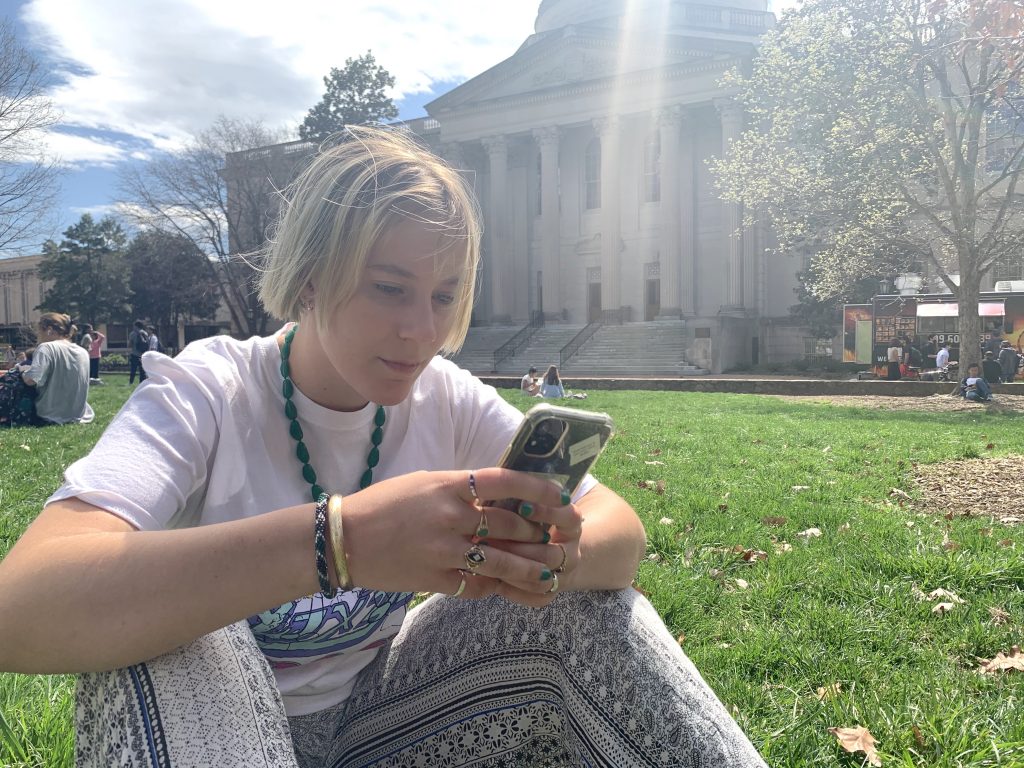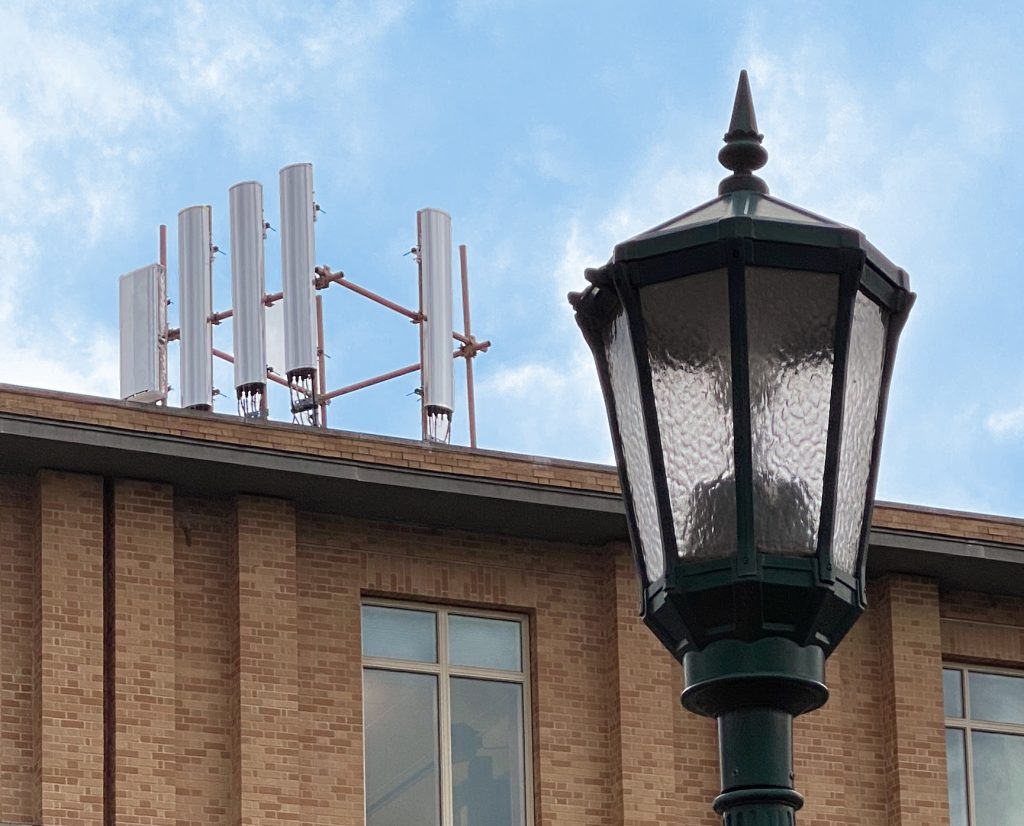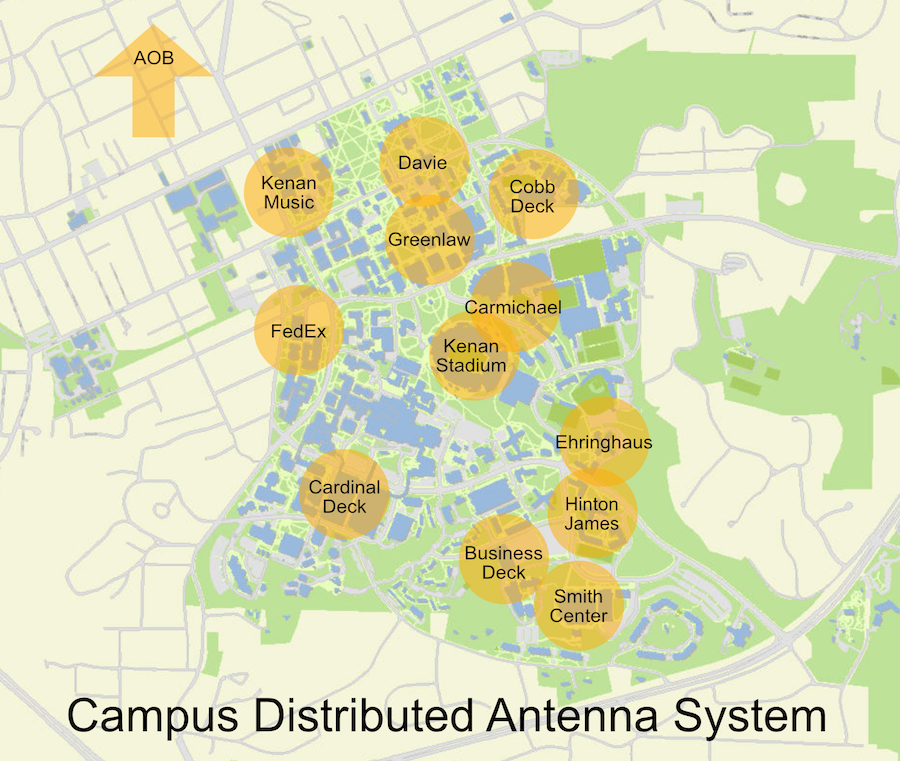
Have you ever wondered how you’re able to use your phone or other mobile devices as you walk from building to building on campus?
Whether sharing a Word document, checking Sakai or updating your socials, data mobility makes it possible to use your wireless device anywhere on campus.
That mobility while using data is something we take for granted today, but it was quite extraordinary a decade ago when ITS and three cellular providers joined forces to make that possible.
“At that time, it was a big deal to be able to leave your desk and be connected in the conference room down the hall,” said Tyler Johnson, a senior member of the ITS Engineering team. He’s worked on the system since it launched.
Network of 13 antennas
Crafted all those years ago, the agreement and system are still what enables University students, faculty, staff and visitors to remain connected to the internet as they traverse campus.
This multi-carrier neutral hosting agreement, as it’s called, is still relatively novel even as the system marks 10 years since ITS activated it on April 1, 2012. The Distributed Antenna System, DAS for short, works by providing data via a network of 13 antennas on buildings across campus. That one antenna system blankets the entire campus. Cellular carriers can connect to the system and their signal goes out.

The partners in this continuing agreement are still Verizon, AT&T and T-Mobile. Carolina’s agreement with the carriers runs another five years, until April 2027.
In the early days
But back to the beginning for a minute. ITS designed DAS to enable campus members to keep using whatever phone they had. Meanwhile, carriers would compete for campus users on price and service. The consortium would pay licensing fees to the University for access to the campus. In return, the University would have improved coverage with little internal support burden.
The need for a solution was considerable.
“When the iPhone was released in 2007, campus cell phone coverage was extremely spotty. But demand for increasingly data-oriented service was growing quickly,” Johnson said.
Back then, AT&T had an antenna on the top of Greenlaw Hall and another on the Hinton James residence hall. Those antennas provided some central coverage, but subscribers to other networks had poor service. Many departments had installed inexpensive cellular boosters with coaxial cables running outside of windows and up to the roof.
“It was pretty clear that mobility was going to be the future, wireless was going to be the future, and it was just a question of how we got there,” Johnson said.
Engineering team manages DAS
For Carolina, a neutral hosting solution — rather than a single carrier solution — was the answer.

“Students don’t want to come to campus and get a new phone with a new plan. They already have a phone, it’s already on their parents’ family plan,” Johnson said.
Johnson and the Engineering team manage the DAS system as part of the team’s role of maintaining the University’s strategic direction for telecommunications infrastructure and services. The group performs design work, consultation, and project management of activities for such services as wiring and construction, fiber, smartphones and mobile data — and this DAS system.
Through the years, the Engineering team has continued to replace and upgrade the antenna equipment and move some antennas to other rooftops to improve coverage. Just think about how the demand for bandwidth has increased as more people carry around multiple wireless devices and use them to Zoom and watch 4K videos.
Coverage wherever you are
Sophie Dubois, a second-year geography major, is one student who values the strong connectivity and her ability to move from the classroom to the dorm to outdoor spaces. “I love being able to work on the quad,” she said. “There is no other way to spend a sunny day on campus.”
The decade-old system has been a success, Johnson said. It provides good outdoor coverage throughout campus. “We have pretty extraordinary reliability and speed,” he said.
That quality of service is a resource that students, faculty and staff have come to rely on and, in fact, demand. It can be used as a recruiting tool.

This strong, reliable connectivity that the DAS system provides also will contribute further to life safety.
New building codes require advanced monitoring and communications capabilities in elevators to enable emergency responders to have a live video feed showing the interior of an elevator and interact with the occupants.
UNC-Chapel Hill “will implement this new technology on campus by using DAS for connectivity, which will further magnify DAS as a critical life safety system,” Johnson said.
Bringing 5G to campus
Now, only five years remain on the contract for DAS, wireless mobile data is growing enormously, and the cellular industry is beginning to move to the fifth generation of network technology, better known as 5G service. Meanwhile, the pandemic and remote work have increased the blurring of personal and work environments.
It’s clear, Johnson said, people will expect even greater mobility, reliability and speed. Amid this landscape, the Engineering team is already actively working on bringing 5G to the campus. Users can expect to hear much more about that over the next several years.
“The student learning experience has already begun moving beyond the brick-and-mortar classroom to courtyards and open common spaces and stretching the limits of the campus wireless network infrastructure,” said John Mack, Assistant Vice Chancellor for ITS Infrastructure & Operations. “Our next generation 5G plan will support connectivity and speed demands which we expect to increase dramatically over the next few years.”
